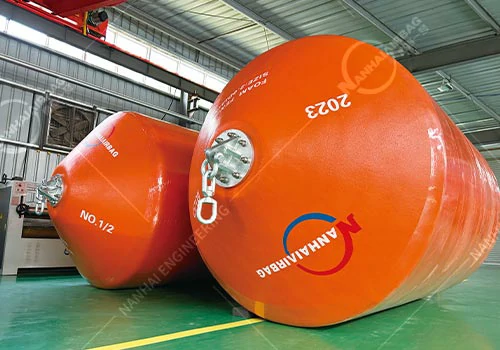Yokohama Fenders in Indonesia: Reliable Protection for Vessels
08/22/2025How Do I Know When to Retire Ship Launching Airbags?
08/26/2025Are foam filled fenders hard to maintain?
No, foam fenders, especially floating foam filled fenders, are generally low-maintenance compared to other marine fender systems. Their solid foam core, durable polyurethane or polyurea skin, and optional chain & tyre net design make them reliable and cost-effective over the long term. However, “low-maintenance” doesn’t mean “no maintenance” — regular inspections and basic care are still essential to maximize service life.

Understanding Foam Filled Fenders
Foam filled fenders, also called floating foam filled fenders, are widely used in ports, terminals, offshore platforms, and ship-to-ship (STS) operations. Their structure usually consists of:
- Closed-cell EVA foam core – absorbs energy without water ingress
- Polyurethane or polyurea outer skin – highly resistant to UV, abrasion, and seawater
- Optional chain & tyre net – adds protection against impact and cutting forces
- End fittings – including swivels, shackles, and towing rings
Thanks to their solid foam design, these fenders don’t rely on air pressure like pneumatic fenders, so there’s no risk of puncture or sudden deflation.

Comparing Maintenance Difficulty
Foam Filled Fenders vs Pneumatic Fenders
- Foam filled fenders don’t require constant air pressure monitoring or inflation.
- Pneumatic fenders demand regular valve checks and air pressure top-ups.
- For operators, foam types save significant man-hours in routine care.
Foam Filled Fenders vs Solid Rubber Fenders
- Foam fenders have a soft reaction force and excellent energy absorption, making them less prone to structural damage.
- Solid rubber fenders, though durable, can be harder to repair if severely damaged.
In general, floating foam filled fenders need less maintenance but still benefit from routine inspections, especially in harsh offshore environments like FPSO operations, LNG terminals, and oil tanker berths.
Recommended Maintenance Schedule
While foam fenders are low-maintenance, a structured inspection plan ensures maximum performance and lifespan:
After Every Berthing Operation
- Check the outer skin for cuts, scratches, or surface damage
- Inspect the chain & tyre net tension and security
- Verify towing ring and swivel connections
Monthly / Quarterly Inspection
- Clean accumulated dirt, oil stains, or marine growth
- Check for minor cracks or peeling on the PU skin
- Inspect chains, shackles, and tyres for wear and corrosion
Annual Deep Inspection
- Perform a buoyancy test to ensure the foam core hasn’t absorbed water
- Measure PU skin thickness and hardness
- Evaluate whether refurbishment or recoating is needed
Foam Fender Maintenance Checklist
| Component | Inspection Point | Action if Damaged |
|---|---|---|
| Outer Skin (PU/Polyurea) | Cuts, cracks, peeling | Minor repair or recoating |
| Foam Core | Signs of water ingress, deformation | Refurbish or replace core |
| Chain & Tyre Net | Rust, loose chains, tyre wear | Retighten, replace if needed |
| End Fittings | Shackles, swivels, towing rings | Lubricate or replace |
| Markings & Reflective Tape | Fading, missing labels | Replace safety markings |
Common Issues and Quick Fixes
- Surface Cuts or Scratches → Use PU repair kits for quick patching
- Outer Skin Peeling → Sand the area, apply primer, and recoat
- Marine Growth Accumulation → Use eco-friendly cleaners and high-pressure washing
- Chain & Tyre Net Corrosion → Replace heavily rusted chains before failure
- Buoyancy Loss → Check for foam water ingress; refurbishment may be required
Cost Efficiency and Total Lifecycle
Foam filled fenders typically have a lifespan of 10–15 years with minimal maintenance. Compared to pneumatic fenders, operators often save on:
- Labor costs for regular pressure checks
- Replacement costs due to puncture damage
- Downtime from sudden deflation incidents
In some cases, damaged floating foam filled fenders can be refurbished, extending their service life by another 3–5 years at a fraction of replacement costs.
Applications in Offshore and STS Operations
- LNG Terminals & FPSOs – high durability and stable buoyancy
- Ship-to-Ship Transfers – excellent energy absorption under dynamic loads
- Ports & Harbors – withstand frequent berthing cycles with minimal wear
Buyer’s Guide: Choosing the Right Foam Fender
When selecting foam filled marine fenders, consider:
- Energy absorption capacity
- Foam density and rebound rate
- Outer skin thickness and material type
- Chain & tyre net specifications
- Warranty, refurbishment, and after-sales support
Conclusion
Foam filled fenders are not hard to maintain — in fact, they’re one of the most operator-friendly and cost-efficient options available. With a simple inspection checklist and periodic cleaning, these fenders can last over a decade, making them ideal for floating foam filled fender applications in ports, offshore facilities, and STS operations.
If you want to maximize the lifespan of your foam fenders, consider setting up a structured maintenance plan or contacting a professional team for refurbishment services.
FAQ
1. Are foam filled fenders hard to maintain?
Not at all. They require far less maintenance than pneumatic fenders but still need regular checks.
2. What’s the main advantage of floating foam filled fenders?
They offer excellent buoyancy, strong energy absorption, and no risk of deflation.
3. Can foam fenders be refurbished?
Yes. A damaged outer skin can be repaired or recoated, extending service life by several years.
4. How often should I inspect foam fenders?
Quick checks after each berthing and deep inspections annually are recommended.
5. Are foam fenders suitable for offshore STS operations?
Absolutely. They perform exceptionally well in LNG terminals, FPSOs, and tanker berths.
